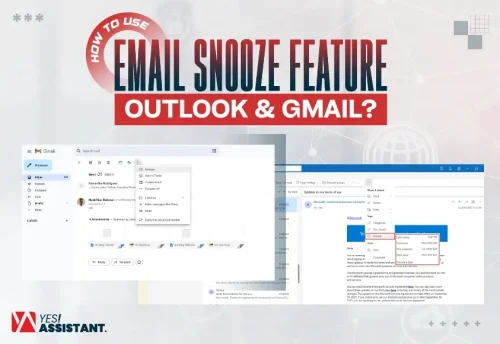
Email Organization Strategies – Pro Tips for Beginners
To ensure better communication, you must organize the emails in a structured way. Otherwise, it can have a negative impact on overall customer and team communication.
In this article, we will go through an in-depth discussion about email organization. These are our core discussion points:
- Major Benefits of Email Organization.
- Useful Techniques to Organize the Emails Properly.
- Implement Advanced Tools and Technologies for the Email Management Process.
Hopefully, you can easily implement all these methods and raise the growth of your communication strategies with the customers and clients.
What's Inside
- What are The Benefits of Organized Email?
- Best Technical Strategies for Competent and Optimal Email Organization
- Advanced Techniques & Tools (Enhancing Efficiency) for Email Management
- Conclusion
What are The Benefits of Organized Email?
Proper email organization helps a business improve its communication system with its customers and competitors. Mostly, it impacts the customer satisfaction of an organization.
Specifically, if you are involved with the email marketing campaign, then your email must be organized for better campaign performance.
In this part, we will discuss in-depth some of the core benefits of organized emails.
Increase Team Productivity
One of the biggest advantages of the organized email is that it improves the overall team productivity. The entire team can easily and effectively focus on their regular tasks. An organized email helps in clear and faster communication, maintains communication through channels, and reduces the time needed to find necessary information from the email.
In terms of team communication, a shared inbox system is more efficient than the individual inbox, and the organized email system always helps. So the entire team can easily track and improve their task management process with proper communication.
Also, preset email templates are good for speeding up team collaboration because they automate the entire collaboration process. Organized email also has proper subject lines, labels, and folders to help in easy access and quick task prioritization.
Better Time Management
Organized email always directly impacts the overall time management process of the team communication. A specific preset time period for email communication reduces the overall hassle. So the team doesn’t have to face any delay in conversation. Also, when you set up the reminders for emails, it will save time for the email management process. Email management is correlated with the calendar management process.
Unsubscribing from unnecessary emails from the inbox is another park for the better time management process. So, organized emails are always better for the overall time management process.
Smooth the Communication Process
An effective communication process is another powerful benefit of an organized email management system. Firstly, organized emails always use descriptive subject lines to express the major purpose of the email. This helps to indicate the core idea of each email for the team members.
Organized email bodies convey the specific information about the purpose of the email with bulleted points and numbered lists that will make the information more precise and clear for the team. Also, the organized email bodies provide clear ideas about the entire conversation.
Flawless Information Retrieval
Organized emails means properly categorized emails with different types of folders, labels, and sub-labels. It can be considered the most significant part of the email organization process. So, categorization helps in finding the right email to get specific information easily.
Also, proper prioritization and sorting help in finding the emails according to the task purpose and demands. Advanced search filters on the email list are very crucial for the information retrieval process. Team members can easily find out their necessary emails from the list without wasting time.
All of the above shows that email organization has lots of benefits for maintaining a company’s communication process with their customers and team collaboration.
In the next section, we will discuss some practical strategies that are effective for a better email organization process.
Best Technical Strategies for Competent and Optimal Email Organization
Effective email organization strategies include some focused factors such as inbox management, folder and label systems, proper filtering rules, email client features, right search strategies, etc. In this part, we will discuss each of them properly.
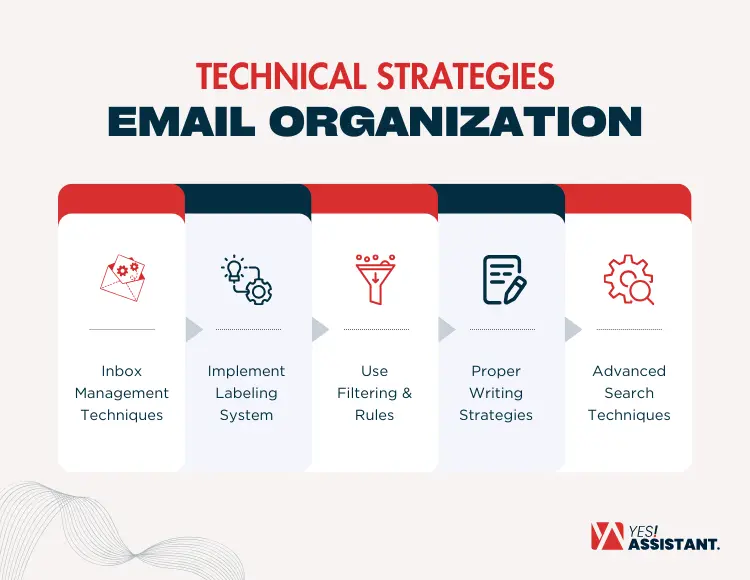
Use Constructive Techniques for Inbox Management
For a better email management process, you must focus on the proper inbox management techniques. There are some factors that are involved with the inbox management process, like prioritizing the emails, using the right filtering process, folder management, etc.
Let’s see some of the core techniques that will help you manage your inbox.
- Check emails on a regular basis according to the scheduled and dedicated time.
- Implement the inbox zero process. It means checking the emails and reducing the number of unread emails.
- Using the predefined email templates is good for inbox management. You can create common email templates for marketing and customer queries.
- Use the snooze feature for the follow-up emails. It will work as a reminder for your entire inbox management process.
Differentiate the Emails with Folder and Label Systems
Using labels or folders is another powerful technique for efficiently organizing the emails and delivering the right purposes. Labeling emails means categorizing the emails based on different purposes that might be marketing, sales, social, customer queries, etc. Folders and labels are similar in the email organization process.
For example, we are showing you the email label system in the Gmail inbox here.
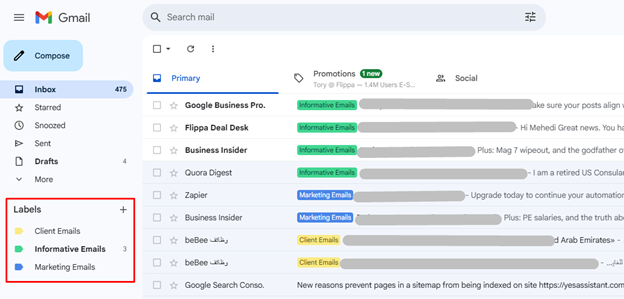
As you can see, all the emails are sorted based on the email labels in the inbox. You can follow this tutorial to create the labels and organize emails in Gmail. Appropriate labeling helps reduce the clutter in your inbox. Also, it impacts the overall task efficiency and productivity.
Follow the Filtering and Rules (Keywords, senders, recipient and attachment)
With the help of filters and rules, you can easily automate the email organization process more effectively. You can create the rules for moving emails to a specific location, as well as delete and mark them based on the subject, sender, and email contents.
There are different filters available in the email management system. In this section, we will discuss some of them.
- Keyword and Phrase Based Filtering Process – Use the specific keyword and phrase for filtering rules. For example, you want to filter out the email that has the word “review”. So create the rules based on this. You can use Gmail search.
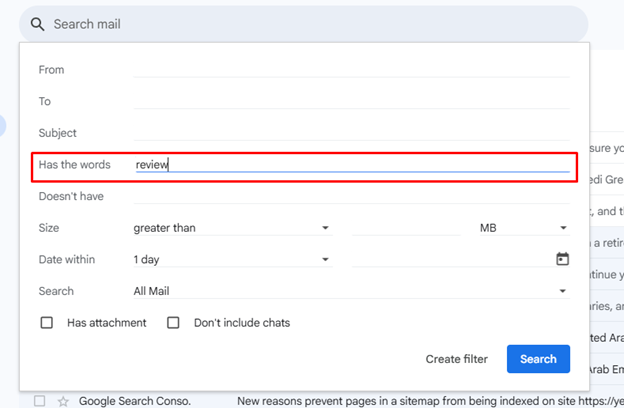
- Recipient and Sender Based Filtering – You can also filter out the email based on sender and recipient from the search bar.
- Attachment filtering – There are options for filtering based on the attachment.
Focus on Appropriate Email Writing and Responding Strategies
Writing well-structured and user-driven content is another core strategy of the entire email organization process because you have to write emails for multiple purposes, such as email marketing, client communication, team collaboration, etc.
We are sharing with you some essential tips for writing emails. Follow and implement them for your regular conversation process.
- You must use a proper and specific subject line to help the recipient quickly understand the entire email.
- The body of the email should be concise and clear, with well-organized information and accurate context.
- Always end the email with a proper closing in a polite style.
- Proofread the email thoroughly before sending it to the recipient.
- Try to respond to the incoming email promptly to maintain a better communication flow.
- Respond to the previous email by adding a prefix like “Re” or “Fwd” on the subject line of the email.
Use Search and Retrieval Strategies by Filtering Options
Although the filtering or retrieving options are enough to find the specific type of email from the inbox list, you can implement some effective techniques specifically for searching the emails from the list.
In this section, we will discuss some core techniques for searching your email inbox.
- Use the specific and descriptive search term on your mail search bar specifically while you are searching based on the subject line of the email.
- For searching the email of a specific time frame, you can use the date search options on the Gmail search bar.
- There are also options for using multiple types of search operators such as “AND, OR, NEAR, NOT” to get the specific email result from the inbox.
- In Gmail, you will get more specified options for searching, like choosing the specific area like Inbox, sent, outbox, etc.
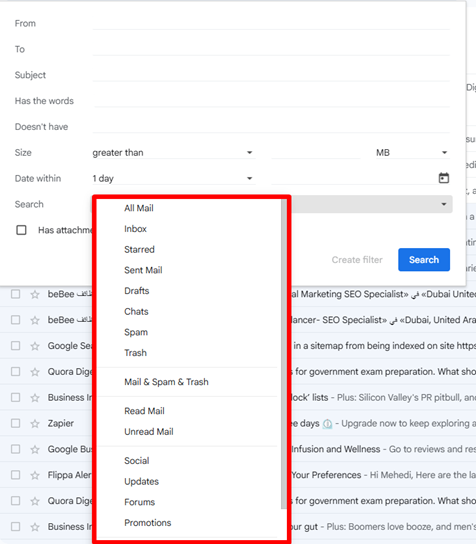
Advanced Techniques & Tools (Enhancing Efficiency) for Email Management
Using advanced tools for email management is always essential for doing all the email-related tasks flawlessly. The tools will help you to prioritize the tasks, automation process, proper team management, regularly reviewing the tasks and refining the tasks properly.
Most of the virtual assistant teams use different types of advanced technology to improve the email management tasks more productively. We will discuss each of the techniques and tools more accurately here.
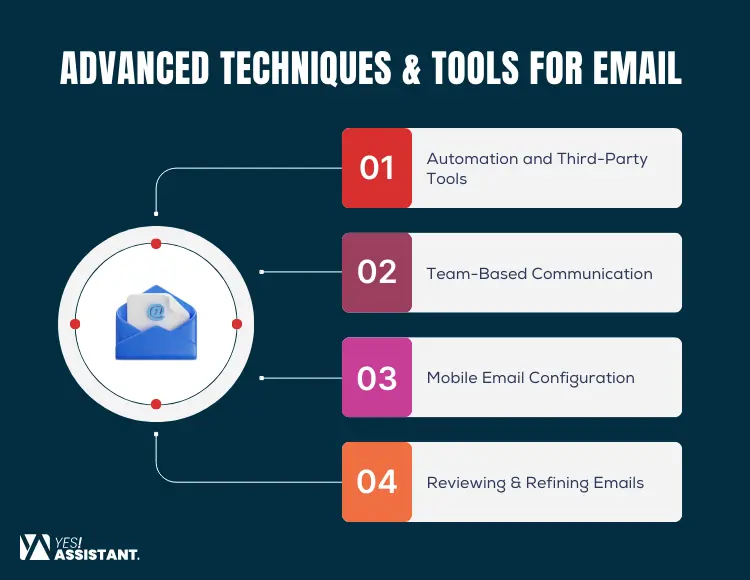
Integrate Automation and Third-Party Tools for Adaptable Email Management
It means that fewer things to do by hand and increasing efficiency for you. This allows you to manage emails more efficiently and with less manual work. The automation process focused on the email marketing process.
“According to the research data of Backlinko, 63% of marketing automation is focused specifically on the email marketing process”
Let’s see how you can easily use the automation system in your email management process.
- Email Filters and Rules – Email filters automatically sort incoming messages to cut down on the noise and help you focus on whatever’s important.
- Sort emails: Use filters to route messages to folders by sender, subject, or keywords.
- Color coding to priority emails: unlabeled to categorize, tag, or color-coded important emails.
- Auto-delete spam – Configure your spam filters to delete junk emails automatically.
Example: set up a rule that moves all invoices (from particular vendors) into an “Invoices” folder automatically.
Email Scheduling
More so, you can schedule emails to send them at the most relevant time without disrupting your workflow. Schedule, in advance, your emails to be sent out: Services like Gmail’s “Schedule Send” and Outlook’s “Delay Delivery” help you schedule when you want the email to go out.
- Immediate Responses: Activate out-of-office responses or auto-dialers for inquiries.
For example: If you are working across time zones scheduling allows your emails to reach recipients at their working hours.
Third-Party Integrations
Linking email accounts with productivity tools can help improve efficiency and collaboration.
- Integration with Project Management tools: Use emails with Trello, Asana, or Monday.com, transforming emails into actionable items.
- CRM Integration: Applications such as HubSpot, Salesforce, or Zoho CRM are connected with the email sync with clients, including interactions that help manage your relationships.
- Email Marketing Integration: Services also connect to software such as MailChimp and ConvertKit to automate bulk emails and response tracking.
For example: Instead of manually entering customer inquiries into your CRM system, automate it using an email-to-CRM integration.
Use Collaborative Email Solutions for Team-Based Communication
For teams processing lots of emails, efficiency and coordination are everything. The above techniques ensure a smooth email workflow.
- Shared Inbox: A shared inbox enables multiple team members to collaboratively access and manage emails.
- Use shared inbox tools: Tools like Front, Help Scout, or Zendesk help teams process customer support emails more quickly.
- Assign emails to specific team members: Clearly assigning emails can help to avoid duplicate responses.
Example: A customer support team using a shared inbox can route inquiries to the appropriate agent rather than having several people reply to the same email.
Email Delegation
Delegating emails ensures proper handling of each inquiry. Save team members time by forwarding emails to the right people. It decreases bottlenecks by sending emails to the right team members. Use cc’ and ‘bcc’ wisely. Don’t take up unnecessary inbox space. Only include relevant parties.
For instance, managers who delegate tasks like project updates to an assistant can forward important emails along with the instructions instead of weeding them out individually.
Standardized Email Templates
Doing the above allows the extra time to be invested in writing formats/templates.
- Set templates for usual answers: Prepare customary responses to frequently asked questions and to queries from clients.
- Have standard signatures with your basics: Regular signatures can be contact info, links, disclaimers, etc.
For example, a sales team can get ready-made email templates for pricing inquiries to reduce the time to respond.
Optimizing Mobile Email Configuration for Secure and Efficient Access
As remote work and on-the-go productivity become the new normal, mobile email management is a must. Mobile email management (MEM) helps to ensure the data security of the IT management and corporate teams.
Mobile email management focuses on privacy policy enforcement, such as device encryption, password requirements, and accessibility. In terms of data protection, it has a proper data loss prevention process.
“According to the research data of OptinMonster, 81% of users prefer opening email on their smartphones”
Here’s how you can easily optimize the mobile email management process.
Mobile Email Apps
Creating specific folders in the app can optimize your email management and retrieval process. Apps like Gmail, Outlook, Spark, and Newton Mail offer premium features for mobile users.
- Syncing on all devices: Getting your mail from your phone, tablet, and desk.
For instance, an executive who travels frequently can address urgent emails on their phone without having to wait until he or she returns to the office.
Small Actions and Smart Responses
Mobile email apps allow eye-saver quick actions to optimize your email management process faster. You can use these techniques to better use the email apps.
- Use swipe gestures: You can customize swipes to trigger actions such as archive, delete, mark as unread, or move to folders.
- Smart replies: AI-generated short responses enable you to respond quickly without composing a complete message.
For example, instead of typing “Thanks, I’ll review it,” tap a common smart reply and send it in seconds.
Offline Access
No internet connectivity when it comes to accessing emails means never having to worry about getting work done while out in the field or in a low network area.
- Use Offline Mode: If you use Gmail and Outlook, you can read and compose emails while not online.
Also follows the synchronize later system. Email gets dispatched automatically as soon as you return online. For example, I could draft replies while on a flight and send them after landing.
Reviewing and Refining Emails on a Regular Basis
If you want to stay productive, take time to review and streamline your email habits periodically. Follow, unsubscribe, and declutter for a better email organization process. With time, inboxes get filled with unwanted and promotional emails.
- Unsubscribe from spam emails: Tools like Unroll. You to bulk unsubscribing from newsletters.
- Create distinct email addresses: Use a different email address for promotions and sign-ups.
Example: Unsubscribing from promotional emails in your inbox and keeping only the relevant ones helps to cut distractions.
Inbox Zero Approach
Always try to use the Inbox Zero method for a clean inbox.
- Have daily archive or category emails: Put done emails into folders to maintain the cleanliness of your inbox.
- Restrict mail checking: Create intervals when you check your mail at all.
For example, looking at your emails three times a day instead of every few minutes helps you concentrate and be more productive.
Analyze Email Performance
Monitoring the efficiency of email is necessary to adjust strategy for better handling. It can impact your entire task management process in different ways. When you monitor the email performance, you will understand the bounce rate and identify the reason.
- Utilize email tracking tools: Seeing when people open your emails with tools like Mailtrack and Yesware can help.
- Test subject lines and response times: Get higher open rates and engagement by knowing past metrics.
For example, if your emails aren’t being opened, you could try a more attractive subject line to improve the response.
Conclusion
Managing emails can be a hassle if you don’t know the right way because email organization involves different types of tasks. Some of the common tasks are categorizing emails, marketing automation, integration with other tools, and scheduling emails.
In this article, we have discussed all about them and their implementation process for your email management system. Hopefully, this will help you improve your entire email organization process and make it more convenient for the clients, customers, and team members.

